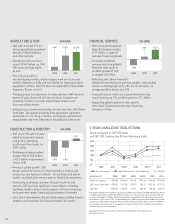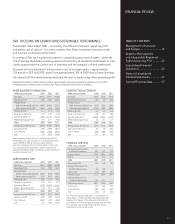John Deere 2011 Annual Report Download - page 20
Download and view the complete annual report
Please find page 20 of the 2011 John Deere annual report below. You can navigate through the pages in the report by either clicking on the pages listed below, or by using the keyword search tool below to find specific information within the annual report.
if this estimated cost experience percent were to increase or
decrease .6 percent, the sales incentive accrual at October 31,
2011 would increase or decrease by approximately $35 million.
Product Warranties
At the time a sale to a dealer is recognized, the company
records the estimated future warranty costs. The company
generally determines its total warranty liability by applying
historical claims rate experience to the estimated amount of
equipment that has been sold and is still under warranty based
on dealer inventories and retail sales. The historical claims rate
is primarily determined by a review of five-year claims costs
and consideration of current quality developments. Variances in
claims experience and the type of warranty programs affect
these estimates, which are reviewed quarterly.
The product warranty accruals, excluding extended
warranty unamortized premiums, at October 31, 2011, 2010
and 2009 were $662 million, $559 million and $513 million,
respectively. The changes were primarily due to higher sales
volumes in 2011 and 2010.
Estimates used to determine the product warranty accruals
are significantly affected by the historical percent of warranty
claims costs to sales. Over the last five fiscal years, this percent
has varied by an average of approximately plus or minus
.05 percent, compared to the average warranty costs to sales
percent during that period. Holding other assumptions constant,
if this estimated cost experience percent were to increase or
decrease .05 percent, the warranty accrual at October 31, 2011
would increase or decrease by approximately $20 million.
Postretirement Benefit Obligations
Pension obligations and other postretirement employee
benefit (OPEB) obligations are based on various assumptions
used by the company’s actuaries in calculating these amounts.
These assumptions include discount rates, health care cost trend
rates, expected return on plan assets, compensation increases,
retirement rates, mortality rates and other factors. Actual results
that differ from the assumptions and changes in assumptions
affect future expenses and obligations.
The pension liabilities, net of pension assets, recognized
on the balance sheet at October 31, 2011, 2010 and 2009 were
$1,373 million, $693 million and $1,307 million, respectively.
The OPEB liabilities, net of OPEB assets, on these same dates
were $5,193 million, $4,830 million and $4,652 million,
respectively. The increase in pension net liabilities in 2011
was primarily due to a decrease in discount rates, partially offset
by the return on plan assets. The decrease in the pension net
liabilities in 2010 was primarily due to the return on plan assets
and company contributions, partially offset by a decrease in
discount rates. The increases in the OPEB net liabilities in 2011
and 2010 were primarily due to the decreases in discount rates.
The effect of hypothetical changes to selected assumptions
on the company’s major U.S. retirement benefit plans would be
as follows in millions of dollars:
October 31, 2011 2012
______________ _________
Increase Increase
Percentage (Decrease) (Decrease)
Assumptions Change PBO/APBO* Expense
Pension
Discount rate** ................... +/-.5 $ (502)/530 $ (22)/21
Expected return
on assets ....................... +/-.5 (45)/45
OPEB
Discount rate** ................... +/-.5 (397)/421 (54)/56
Expected return
on assets ....................... +/-.5 (6)/6
Health care cost
trend rate** .................... +/-1.0 886/(683) 199/(152)
* Projected benefit obligation (PBO) for pension plans and accumulated postretirement
benefit obligation (APBO) for OPEB plans.
** Pretax impact on service cost, interest cost and amortization of gains or losses.
Goodwill
Goodwill is not amortized and is tested for impairment annually
and when events or circumstances change such that it is more
likely than not that the fair value of a reporting unit is reduced
below its carrying amount. The end of the third quarter is the
annual measurement date. To test for goodwill impairment,
the carrying value of each reporting unit is compared with its
fair value. If the carrying value of the goodwill is considered
impaired, a loss is recognized based on the amount by which the
carrying value exceeds the implied fair value of the goodwill.
An estimate of the fair value of the reporting unit is
determined through a combination of comparable market values
for similar businesses and discounted cash flows. These estimates
can change significantly based on such factors as the reporting
unit’s financial performance, economic conditions, interest
rates, growth rates, pricing, changes in business strategies and
competition.
Based on this testing, the company identified one
reporting unit in 2010 and one reporting unit in 2009 for
which the goodwill was impaired. None were impaired in
2011. In the fourth quarter of 2010 and 2009, the company
recorded a non-cash pretax charge in cost of sales of $27 million
($25 million after-tax) and $289 million ($274 million after-tax),
respectively. The charges were related to write-downs of the
goodwill associated with reporting units included in the
agriculture and turf operating segment. The key factor contrib-
uting to the impairments was a decline in the reporting units’
forecasted financial performance (see Note 5).
A 10 percent decrease in the estimated fair value of the
company’s reporting units would have had no impact on the
carrying value of goodwill at the annual measurement date in
2011.
20
























